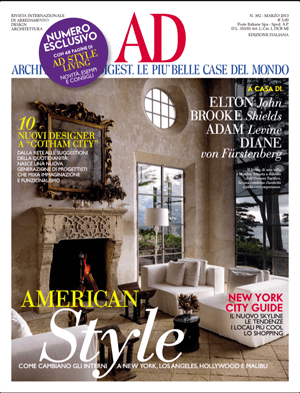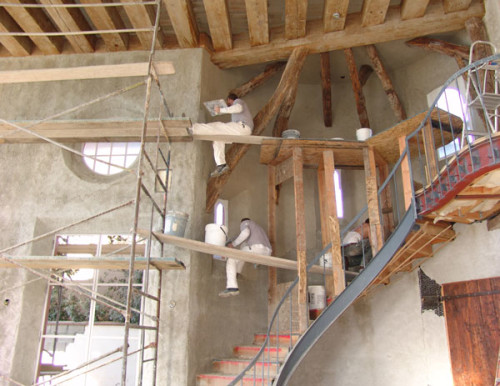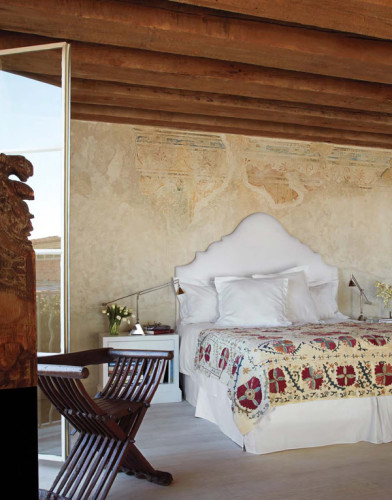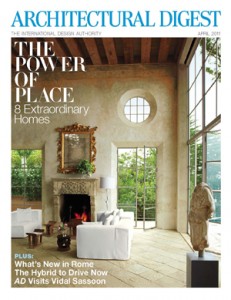by Anatoly Valenti
Malibu Fresco, Before and After… in reverse…

Architectural Digest Italy, March 2013
“We plastered and painted in true fresco every wall and ceiling in this house, years, decades, then centuries have passed and there were only a few frescoes left. We had to come back and plaster and paint again and again and again over the old ones and over the new that became old themselves. Now, centuries later, there are just a few left worn out in most places all the way down to the horse-haired, volcanic ash plaster.”
A Malibu beach-front retreat built by art collector, designer and antiques dealer Richard Shapiro has “the look, age and aura of a very old, windswept structure from the Mediterranean or the Aegean.”
All walls in the house are sheathed in frescoed plaster and partially covered by the Renaissance-style frescoes created by fresco artist iLia Anossov, founder of Fresco School in Los Angeles. iLia, one of very few artists in the world who is considered masters of the art of fresco painting, has shared some of the inspiration and techniques he used while working on this project.
What makes fresco paintings so unique?

Malibu Fresco – building fresco walls, grand room
For centuries fresco has been the most prominent form of art across cultures and continents. Frescoes were painted by the Aztecs, Egyptians, Hindus, Chinese, Europeans and Modern Americans alike. Fresco signifies eternity of art and creates a unique feeling of time, history, and interconnection of different cultures spanning throughout centuries.
Are all walls of the house covered with frescoes?
We started with an idea of putting small fragments of frescoes in several parts of the house. However, it quickly became evident that to create a true feeling of ageless ruin for the entire house the whole house must become that ‘fragment’. Each separate remnant of fresco remaining on the wall had to be interconnected with each other, which is only possible if it is part of the design of the entire house.

Malibu Fresco – Loft Bedroom aged fresco walls
How did you make frescoes look so authentic?
These frescoes not just look authentic. They are authentic. They are made with same materials and following same wet plaster painting techniques used by the great fresco masters of the Renaissance era. The only thing that we have altered was the speed of passage of time.
What do you mean by altering the speed of time?
I had to first create new frescoes as they would have been painted fresh by a fresco master several centuries ago. Then we rushed them through time ‘back’ into the future of the modern era by literally destroying most of what was created. At first, paintings on the walls looked so crisp, vibrant and new that the task of scraping off most of the paint and plaster throughout the surface seemed almost inconceivable. However, as we went stroke by stroke with the spatula and sand paper, it felt like centuries were passing by advancing us into the modern age and giving the house such a distinct sense of time and a feeling of an ancient refectory or a long-abandoned Renaissance chapel tastefully combined with airy windows and elements of modern furniture.
How were you able to create such an ancient feel of the house?

Architectural Digest, April 2011
It is really not enough to paint a fresco and make it look distressed. We created multiple layers of frescoes with each layer representing a certain time period. Imagine that the house was abandoned in 19th century, a lot of walls were damaged and you can see layers of plaster revealing multitude of underlying layers of plaster. Imagine that the last time the house was decorated was in the early 18th century, so the top layer of plaster shows the remains of frescoes of that era.
However, underneath we see the previous layer where you can recognize Renaissance frescoes painted in early 1700s. Some places on the walls are “damaged” even more revealing even older layers of plaster dating back to 15th century when the house was “originally” built and the walls were painted in frescoes for the first time.
When you take a closer look at the walls you will see that different layers have different texture and different composition – from a simple sand and lime mixture to marble dust, volcanic ash and horse-hair plaster. Indeed, methods of preparing plaster and its composition vary in different centuries. We used historical data accumulated over the years by the Fresco School on how fresco plaster was prepared during the time periods that we were recreating.
What about the paint? What kind of paint did you use?

House & Garden, March 2013
Fresco is the only pure “organic” or “green” method of painting – no solvents, glues or man-made materials are used. Pigments are prepared from natural minerals and clays. Plaster is made of calcium lime putty and sand. As wet plaster reacts with the air and calcify (cures) it permanently binds pigments to the surface of plaster leaving works of art intact for generations and millennia. In fact, a house made in fresco is fully breathable and will never get mold or bacteria.
What are you working on now?
Currently, I am working on a fresco collection for a gallery exhibition and I am in the design stages for a large scale Fresco Project at the Cohoes New York. I teach Fresco Painting at the Getty Villa in Malibu and privately at the Fresco School which I have founded over 20 years ago in Los Angeles.
about the Artist:
iLia Anossov (fresco) is one of the few artists in the world considered a master of the art of fresco painting. His fresco work includes paintings, installations, objects, sculptures and his signature fresco “stacks”.
iLia has been widely exhibited in Russia, Europe and the United States including 7 museum exhibitions and over 50 solo and group exhibitions. Commissions include large-scale fresco installations and murals in private homes and public areas. His internationally featured Malibu Fresco project appeared on the covers of premier magazines including Architectural Digest (AD) USA/Germany/Italy, House & Garden UK.
iLia’s creative mind and artistic excellence has been in high demand for prestigious events and productions. One of his most notable commissions was the design and creation of the interior décor of the 76th Annual Academy Awards® Governor’s Ball. Over 27,000 sq. feet was hand painted in t”rompe l’oeil frescoes”. iLia’s work has graced such events as the 73rd Academy Awards® Governor’s Ball, 9th Annual SAG Awards Governor’s Ball, 50th Annual Emmy Awards, 11th Nickelodeon Kids Choice Awards and many others.